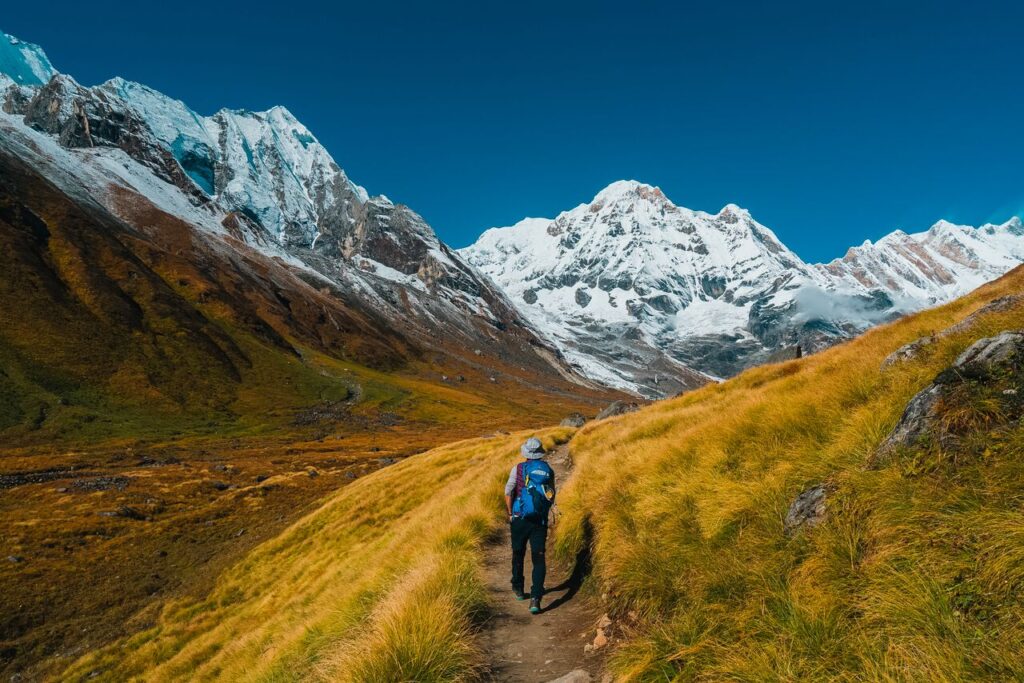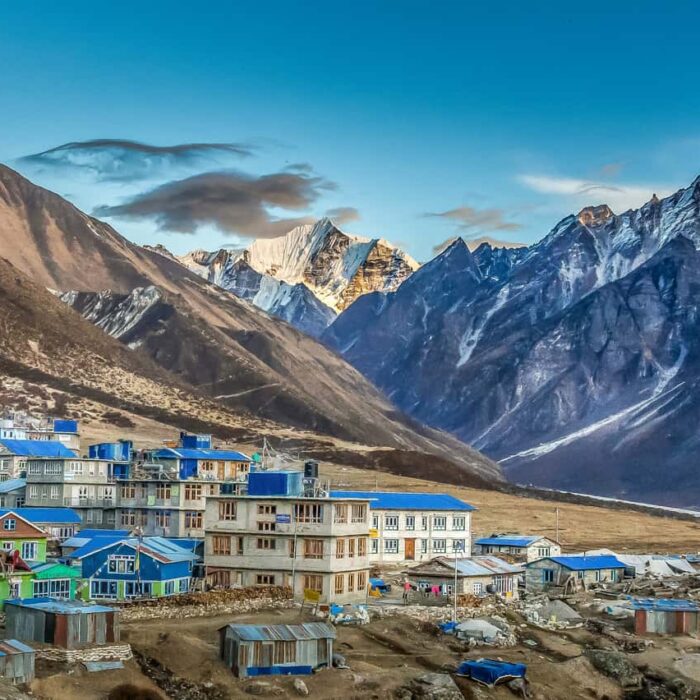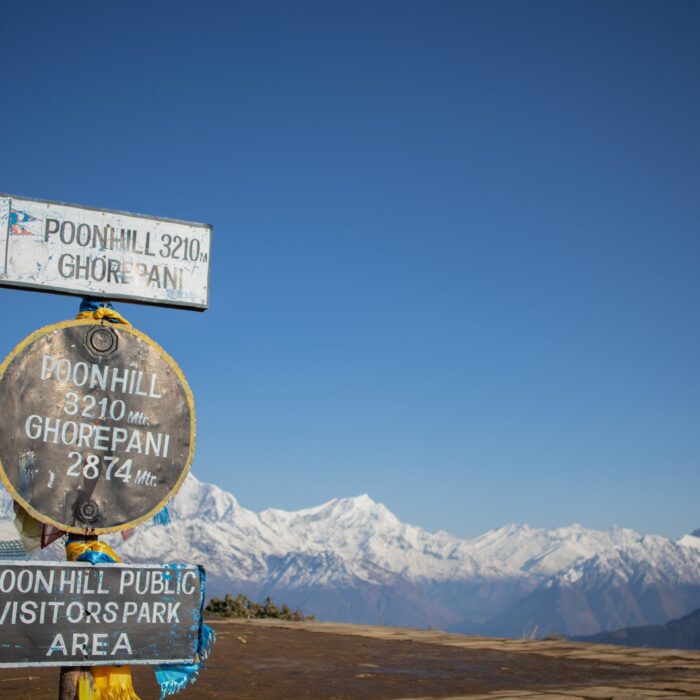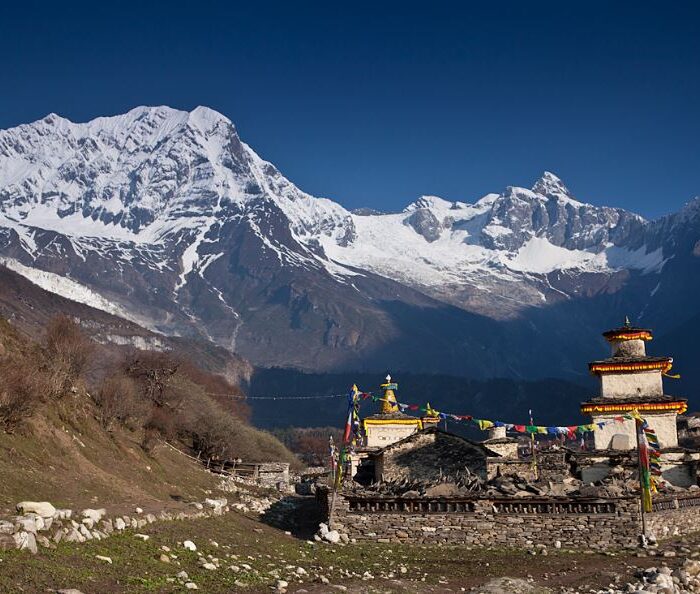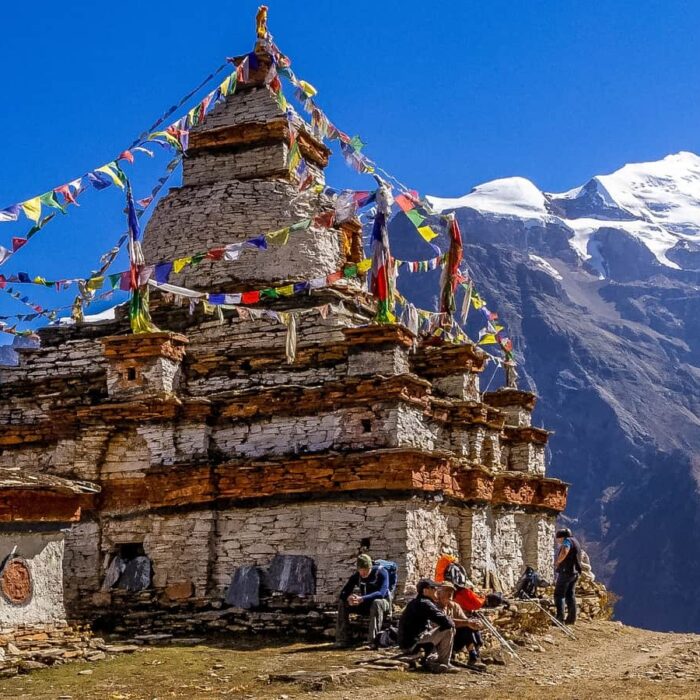The 10-day Annapurna Base Camp Trek is truly a super adventure trek. Starting in Pokhara, this trek leads you through lovely Gurung and Magar villages, going through lush Rhododendron forests and bamboo groves. Furthermore, you’ll trek to the lovely Annapurna Base Camp at a height of 4130m (13546 ft). It is where the sight of the grand peaks will leave you in awe without a doubt.
Annapurna I: A Majestic Marvel
Reaching the base of the grand Annapurna I (8091m) is a great mountain episode. People who go on this trek will set this moment into their memories, and consider this as a big reward in their lives. This moment holds a unique value for every person.
Cultural Enrichment Along the Trail
The trek to Annapurna Base Camp will introduce you to diverse ethnic groups. Thus, adding an extra layer of things to the 10-day trek. Starting with Brahmins and Chhetri at lower heights and progess into the Himalayan regions. They are full of people from Gurung and Magar communities. The trek also offers a sight into various factors of Nepali life.
Gurkha Heritage
Famous for its Gurkha soldiers, the region carries a rich historical and strong essence. Thus, it contributes to a deeper understanding of the local culture.
Accommodation Overview
During your trip to Annapurna Base Camp, the quality of places to stay varies. In both the Annapurna and Everest regions, places to stay and food options tend to be better compared to other trek spots. Although they may not match the standards found in urban areas. It’s a must to note that, beyond Chhomrong village, the availability of a place to stay varies. Thus, it reflects a keen effort to preserve and protect the surrounding environment.
In the Annapurna and Everest regions, you can generally expect more comfortable lodges and a wider variety of food choices, giving service to the needs of travelers. However, as you go beyond Chhomrong, the focus on environmental conservation limits the number of places to stay. It is done to ensure the validity of the area. You need to be open for shared dorms in higher areas.
Prepare for a mix of lodging experiences along the trek. The trek ranges from nice lodges in popular trek regions to more basic places to stay in remote areas. This trek allows you to immerse yourself in the unique landscapes with respect to the guard efforts in place.
Extending the Adventure Beyond Annapurna Base Camp
For those seeking to further the trek experience, consider walking back through lovely villages following your visit to Annapurna Base Camp. The Annapurna Base Camp route includes lovely villages such as Ghandruk, Landruk, Tolka, Pothana, and Australian Camp. This extended trip not only provides additional chances to immerse yourself in the local culture but also allows for a deep connection with nature.
Ghandruk, with its traditional Gurung settlement, offers insights into the pure local lifestyle. Whereas, Landruk provides a clear setting for cultural exploration. Tolka, nestled amid lush landscapes, and Pothana, surrounded by rhododendron forests. These forests indeed add diverse elements to your trek. Australian Camp, known for its wide views, serves as a worthy climax to your extended trip.
By choosing this Annapurna Base Camp route, you not only expand your cultural experiences but also get to feel and love the natural beauty of the region from a different angle. The additional villages enrich your trek journey. Thus, making it a more complete and worthy trek.
Other trek options
Besides the Annapurna Base Camp 10-day trek, we have other trek options and they are:
Please check our trek equipment list. This list will be a guide for you if you plan to trek in Nepal. Similarly, you can check our AMC (Acute Mountain Sickness) which can be a good guide for you to learn more about getting ill at high heights in Nepal. Also, if you want to do a Peak climb in Nepal then please check the climbing equipment list that is a must while going on the Peak climb. Likewise, we suggest you check the updated TIMS card rule as there have been some new changes in Nepal.
Booking is Open for 2024 / 2025
Are you planning to do a trek or tour in 2024? If so, then in our Best Deals part, you can find the ideal information on the best price for the trek cost. Furthermore, book plans as soon as possible.
Contact us or Send a message or call us at
WhatsApp / Viber / Mobile: + 977 – 9851 022814, + 977 – 9841 451681
We are available 24/7
For further info, Contact us.
Itinerary
Day 1: Drive Kathmandu – Pokhara (200 Kms/7-8 Hrs) by Tourist Bus
Early morning at 0630 AM, our driver will come and transfer you to Kathmandu tourist bus station to board the Tourist Bus to Pokhara together with your trekking staff escorting from Kathmandu. Board a deluxe bus on a sharing basis following the scenic mountain highway to Pokhara from Kathmandu. Upon arrival, transfer to your hotel. The rest of the day is free to stroll around the Phewa lakeside area.
Overnight at Hotel in Pokhara
Day 2: Drive to Nayapool. Trek to Ghandrung (1950m/5 hours trek)
Morning, pick up your guide from your hotel and drive to Nayapool along a scenic mountain road. Arrive at Nayapool and start your trek to Ghandrung village which is the biggest Gurung settlement located on the lap of the Annapurna South and Hiunchuli Mountain. In Ghandrung visit the local village and museum to explore the traditional Gurung culture and lifestyle.
Breakfast & Overnight at Local Lodge
Day 3: Trek from Ghandrung to Chhomrong (2170m/6 hours trek)
You will descend from Ghandrung Hill Ridge to Kimrung Khola. Visit the village settlement located on the riverside. Start your uphill climb to Chhomrong. Upon arrival, check-in at the local lodge with an excellent view of Annapurna South, Hiunchuli, and Fishtail Mountain.
Breakfast & Overnight at Local Lodge
Day 4: Trek from Chhomrong to Bamboo (2310m/4 – 5 hours trek)
Start the trekking from Chhomrong following 2500 stone steps down to Chhomrong Khola. Trek uphill for 1.5 hours to reach Sinwa. From there follow the trekking trail carved inside the forest area to reach Bamboo.
Breakfast & Overnight at Local Lodge
Day 5: Trek from Bamboo to Deurali (3230m/4 hours trek)
Follow the Modi Khola river bank along the forest area to reach to Doban. Continue your walk to the Himalaya from where the trail opens with an excellent first close glimpse of Annapurna South.
The landscape changes with vegetation with a view of the valley down surrounded by stiff rock cliffs. Reach to Deurali and overnight here. We recommend overnight at Deurali to avoid cases of altitude sickness as this rest allows your body to adjust to the increased altitude.
Breakfast & Overnight at Local Lodge
Day 6: Trek to Annapurna Base Camp (4,130m) via Machhapuchhre Base Camp – 6 hours trek
From Deurali the trek lowers to the Bagar. Cross the glacier stream and start your climb to Machhapuchhre Base Camp located at an altitude of 3700 meters. From Machhapuchhre Base Camp you will see rewarding views of Machhapuchhre, Hiunchuli, Annapurna South, Annapurna I, Annapurna III, Gandharvachuli, and Gangapurna. From this place, you will notice that we already reached the other side of Fishtail Mountain which we see from Pokhara hence the shape of the peak changes. After spending time for lunch at base camp, you will start an uphill climb to Annapurna Base Camp further for 1.5 – 2 Hours reach to the ultimate destination of our trek – ANNAPURNA BASE CAMP. Annapurna Base Camp is located at an altitude of 4130 meters above sea level offering a 360-degree view of Machhapuchhre, Annapurna South, Annapurna I, Hiunchuli, and other peaks. Spend the rest of the day enjoying the dramatic sunset view and the landscape.
Breakfast & Overnight at Local Lodge
Day 7: Trek from Annapurna Base Camp to Doban – 7 hours trek
Early morning enjoy sunrise over the Himalayas from base camp. The sunrise view from Annapurna Base Camp is a rewarding experience with dramatic changes in the color of the peaks. After breakfast, trek down to Doban following the earlier route.
Breakfast & Overnight at Local Lodge
Day 8: Trek from Bamboo to Jhinu Danda (1760m/6 hours trek)
Trek to Chhomrong following the same trekking route that we followed while trekking up to Base Camp. You will stop at Sinwa or Chhomrong for lunch and then continue to Jhinu Dada undertaking a downhill climb from Chhomrong. Check-in at the local lodge. If time permits and you are interested then take a small walk down to Modi Khola river bank to enjoy your time at Hot Spring relaxing your muscles.
Breakfast & Overnight at Local Lodge
Day 9: Trek to Naya Pul then drive to Pokhara: 7 hours trek, 1 hour drive
Morning you will trek down to Nayapool. Board the vehicle to drive to Pokhara. You will get transferred to your hotel.
Breakfast & Overnight at Hotel in Pokhara
Day 10: Drive to Kathmandu by Tourist Bus
Board an early morning tourist bus to drive back to Kathmandu. Upon arrival, check in at your hotel booked on your own.
END OF THE SERVICES!
Include / Exclude
Cost Includes
- Kathmandu hotel to Bus Park transfer or V.V on Day 01 & Day 10
- Kathmandu/Pokhara & Pokhara/Kathmandu tourist bus ticket on a sharing basis
- Pokhara/Nayapool & Nayapool/Pokhara surface transfer
- 2 nights at Hotel in Pokhara (3*) with breakfast
- 8 days Annapurna Base Camp Trek using local lodges with breakfast
- For one person: English-speaking porter Cum Guide. For two & above pax: one experienced trek guide & one porter on every 2 persons
- Trekking crew allowances, food, lodges, and staff insurance
- Annapurna Conservation Area Permit fee as applicable
- Trekking Information Management System fee (TIMS) as applicable
- Government taxes as applicable
Cost Excludes
- Service excludes trekking equipment which can be rented in Kathmandu at extra cost, Hot water (Boiled drinking water)/Hot Shower & Battery Charges during the trek, arrangements in Kathmandu, Lunch & Dinner at Local Lodges during the trek, and gratitude to the trekking crew.
Map
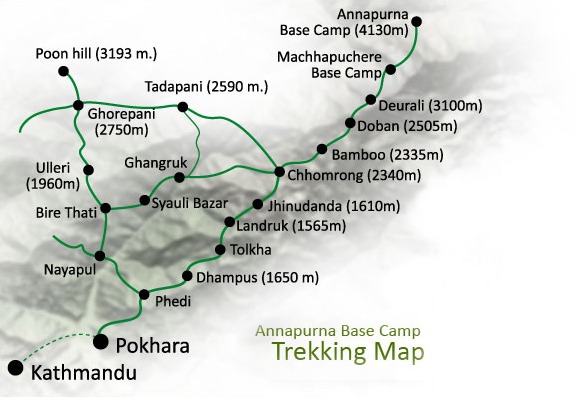
Frequently Asked Questions (FAQ)
Q1. What is the accommodation like at Annapurna Base Camp?
During the trek, accommodation will be in local lodges, which are simple and differ from city hotels. The lodges have common bathrooms, and at higher elevations like Annapurna Base Camp (ABC), dormitory-style accommodations might be necessary due to limited availability. As this trek is popular among locals (Nepalese), it can get crowded, especially after Chhomrong, leading to the use of shared lodges with other trekkers.
Q2. What are meals like at Annapurna Base Camp?
We will provide you a simple breakfast as per your package program however we will be more than happy to offer all kinds of meals if you book the full package program with us at extra cost.
The Annapurna Base Camp Trek offers a delightful experience of local Nepali cuisine. Along the trek, you will find a wide variety of traditional dishes available in tea houses and lodges. One of the highlights is “Dal Bhat,” a staple dish of Nepal, which is commonly served and includes a combination of rice, lentil soup, and vegetable curry. Enjoy the rich flavors and taste the authentic Nepali flavors during your trekking adventure.
Q3. Why is the Annapurna Base Camp trek popular?
Annapurna 1 stands tall at 8091 meters, ranking among the world’s highest mountains. The surrounding sister peaks also contribute to breathtaking panoramas from every angle. The trek showcases diverse terrain, ranging from serene lowland pastures and tranquil villages to awe-inspiring glaciers and majestic mountain vistas.
Q4. How long does it take to climb Annapurna from base camp?
The Annapurna Base Camp trek can be accessed from multiple trailheads, allowing for flexibility in your route. The duration of the trek varies depending on the chosen trail, ranging from 6 to 12 days. This adaptability enables trekkers to select a suitable itinerary that fits their preferences and time constraints.
Q4. Is there a mobile network in Annapurna Base Camp?
Yes, there is mobile network coverage in Annapurna Base Camp. While trekking along the trails, you can find cellular networks from Ncell or NTC (Nepal Telecom Corporation) in most of the small villages and along the trekking route. This mobile network availability allows trekkers to stay connected and communicate during their journey to the Annapurna Base Camp.
Q5. What should I wear to Annapurna Base Camp?
Indeed, a waterproof layer is essential for the Annapurna Base Camp trek. This layer should consist of a reliable rain jacket and waterproof pants. The weather in the mountainous regions can be highly unpredictable, and carrying protective clothing is crucial to stay dry and comfortable during the trek.
Rain showers are common in the Himalayas, and having a waterproof layer will protect you from unexpected downpours and keep you warm in case of chilly conditions. Being prepared with proper rain gear ensures that you can fully enjoy the trek and focus on the breathtaking scenery without worrying about getting wet or cold.
Q6. Do you need a sleeping bag for Annapurna Base Camp?
While you don’t necessarily need to pack a sleeping bag for the Annapurna Base Camp trek, it is advisable to consider bringing one. The teahouses along the trail do provide thick synthetic comforters, which they refer to as blankets. However, during high season when the number of trekkers increases, there is a possibility that the teahouses may run out of blankets.
Having your sleeping bag ensures that you have a comfortable and warm night’s sleep regardless of the availability of blankets in the teahouses. It provides an added layer of comfort and security during your trek, especially in colder conditions or when the teahouses are crowded. Therefore, while it may not be mandatory, packing a sleeping bag can be a prudent choice to enhance your trekking experience.
Q7. Is the Annapurna Base Camp trek crowded?
During the peak spring season, Annapurna Base Camp can get crowded with trekkers. However, in March, the camp receives fewer visitors as the weather is still transitioning from winter to spring, making it a less crowded time to trek. While the weather may be delicate during this period, the landscape begins to bloom with colorful flowers and rhododendron forests, offering a serene and picturesque trekking experience.
Q8. Is Annapurna harder than Everest?
If you have uncertainties about your mountaineering skills, the Annapurna Circuit is a relatively less challenging option. It involves fewer steep climbs and maintains a lower average altitude compared to Everest. Additionally, you have the freedom to choose from various trails, some of which do not exceed 2000m in altitude, offering a diverse and enjoyable trekking experience.
Q9. Which is better Annapurna Base Camp or Circuit?
The Annapurna Circuit trek is longer and more challenging than the Annapurna Base Camp trek. It demands a longer duration (at least 12-16 days), more financial investment, higher physical fitness, and trekking experience.
Q10. Which is the shortest route for the Annapurna Base Camp trek?
The Annapurna Circuit trek reaches an impressive altitude of 5,420m/17,782 feet, while the Annapurna Base Camp trek’s highest point is at 4,131m/13,553 feet. Both treks offer fantastic experiences, but the Circuit trek is undeniably more physically demanding due to its higher altitudes and longer duration. Choosing between the two will depend on your trekking experience, fitness level, and the type of adventure you seek.
Q11. How do I prepare for the Annapurna trek?
If possible, consider undertaking training hikes at high altitudes to better prepare both physically and mentally for the challenges of high-altitude trekking. Experiencing the increased strain on your body during training will help you acclimate to the higher elevations and build the necessary stamina for your trek. While not everyone has access to high-altitude training, if you can arrange it, we highly recommend doing so for a more enjoyable and successful trekking experience.

